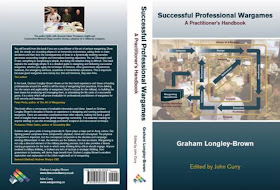I've managed to trawl through my emails and found some of the comments that had been 'lost'. I will attempt to find more, but I suspect that they might be unrecoverable.
28th October 2019
Trebian has left a new comment on your post "To Ur is Human":
Bob,
Following your review here I had my best ever day for sales, hitting the dizzy heights of 4 copies!! There were a couple the next day too, so I'm crediting you with 6, not counting the one you bought. Nice review over on Amazon, too.
Thanks for your support,
Trebian
Trebian has left a new comment on your post "To Ur is Human":
It would help if you were to post a review on TMP, as that probably circumvents the no commercials without paying for advertising rule.
29th October 2019
Archduke Piccolo has left a new comment on your post "The Chaco Air War 1932-35":
I had an idea I'd seen this pic before. Maybe you had a blog entry on it. I recall two or three years back reading up online about the Chaco war, having my attention drawn to it be someone!
4th November 2019
KEV. Robertson. has left a new comment on your post "A busy week ahead":
Hi Bob,
Keeping fingers crossed for you that your eye test at Bluewater goes well for you...perhaps you may only need an upgraded script for your close work Glasses. Thinking of you - and have a great time with your Lodge and Freemasonry Friends. Cheers. KEV.
5th November 2019
Mark, Man of TIN has left a new comment on your post "Stuart Asquith, RIP":
Sad News - Stuart will be fondly remembered.
I am lucky to have and command some of Stuart's 15mm Peter Laing Romans and Picts.
https://manoftinblog.wordpress.com/2019/11/05/a-muffled-drum-for-stuart-asquith/
Archduke Piccolo has left a new comment on your post "Stuart Asquith, RIP":
I recall Stuart Asquith's articles on the English Civil War and World War One back in 'Battle Magazine' days. The latter series sure tempted me to give WW1 a try, but I had less money and less time in those days.
I have a copy of his book, jointly authored with C.S. Grant, 'Scenarios for all Ages' - what I call 'the Red Book.'
Unknown has left a new comment on your post "Stuart Asquith, RIP":
Thank you all for your lovely words about Stuart, my father.
He would have been so humbled by everyone’s kind words. My mother, my sisters an I are so proud that he influenced so many people across the wargaming community. Your stories and happy memories help us in these difficult times.
Regards
Tom
Mark, Man of TIN has left a new comment on your post "Stuart Asquith, RIP":
How wonderful to have some of Stuart's Napoleonic figures.
Via Henry Hyde, I had a lovely email from Tom his son, as you have below, about how very touched the family are by all the tributes at this difficult time.
Tom invited us all to raise a glass to Stuart wherever we are on the 18th December, the date of Stuart's funeral.
Tony ('Tin Soldiering On' blog) Kitchen suggested, that we get out the shiny toy soldiers in a game in his memory. No finer tribute ...
Mark, Man of TIN
6th November 2019
David Crook has left a new comment on your post "Modelling barbed wire entanglements: The completed...":
Hi Bob,
These look really nice and will certainly give the Soviet steamroller something to drive over....
All the best,
DC
7th November 2019
feedmegames.com has left a new comment on your post "Other people's Portable Wargame battle reports: An...":
Interesting concept. Almost like a boardgame.
Maudlin Jack Tar has left a new comment on your post "Other people's Portable Wargame battle reports: An...":
Thanks for sharing my game with a wider audience Bob!
8th November 2019
Ross Mac rmacfa@gmail.com has left a new comment on your post "Other people's Portable Wargame battle reports: An...":
Well worth highlighting!
KEV. Robertson. has left a new comment on your post "Other people's Portable Wargame battle reports: An...":
Hi Bob,
My first ever Toy Soldiers were a packet of OO/HO AIRFIX American Civil War UNION Infantry- they are great figures. Cheers. KEV.
9th November 2019
Archduke Piccolo has left a new comment on your post "Petsamo and Kirkenes 1944":
Potential for a small campaign there possibly? A 'Very Wintery War', perhaps?
10th November 2019
Ross Mac rmacfa@gmail.com has left a new comment on your post "Remembrance Day":
I remember the foolish thoughts of a young officer at military college who was disappointed that he was serving after the last war had been fought. Such a fool in so many ways. The older version is glad he missed having the personal experience and sad that others, including the not yet born, haven't.
(I have to admit to some curiosity, we commemorate on the 11th regardless of day of the week and I was surprised to hear that your main national ceremony is today.), the 10th.
Geordie an Exiled FoG has left a new comment on your post "Petsamo and Kirkenes 1944":
Nice spot.
I do like a bit of bookshop browsing the old-fashioned way of doing things.
















































